The dry continues, and with a lot more heat showing up. Remember that most pests will grow, develop, and reproduce more quickly in warmer conditions.
Crystal Stewart from Cornell Cooperative Extension reminds us that with the continued dry weather, providing consistent water is very important for alliums to size up well.
Potato leafhoppers have started showing up in MA, RI & VT and likely elsewhere as well. Be on the lookout and prepared to protect potatoes and other favored host crops.
Squash vine borer moths have been found in MA and NH. If you are in a part of Maine with similar climate, protective row cover should go on now, and if not be prepared for egg hatching starting next week. If elsewhere, adjust timing accordingly.
Berry growers in NY state are reporting very early sightings of spotted wing drosophila, but I have not heard any reports from within New England, yet.
Squash bugs are out now and laying eggs.
Now is the time to start scouting and testing for problems in seed garlic like garlic bloat nematode or white rot. https://extension.umaine.edu/ipm/how-to-send-a-plant-sample/ See this Pest Report from last year for more information about garlic problems, including white rot and garlic bloat nematode.
With the continuation of dry weather, and now more heat, onion thrips numbers are likely to increase, as mentioned in the previous report.
The second flight of leek moths is expected to occur soon, this is usually the more damaging generation of the new pest. If you live in northwestern Maine, see this previous Pest Report for more info.
If you have trouble viewing an image, try clicking/tapping on it to open up a new window with a larger image.
Potato Leafhopper Alert
Squash Bug
Tortoise Beetle
Squash Vine Borer
Spotted Wing Drosophila
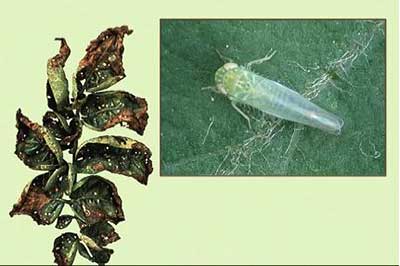 |
| Potato leaves damaged by leafhoppers (left) with leafhopper (right) greatly enlarged. |
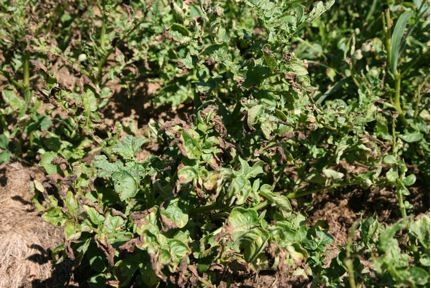 |
| Leafhopper damage on potato leaves, called “hopperburn.” |
POTATO LEAFHOPPERS (Empoasca fabae)
By Eric Sideman
The potato leafhopper has been arriving here in New England earlier and earlier. If you see unexplained yellowing of leaves of beans or potatoes, check for the critter. They primarily feed on beans, potatoes, eggplants, strawberries and alfalfa, but will also damage hops.
PLH does not overwinter anywhere near here. They overwinter way down south on the coast of the Gulf of Mexico, and leapfrog up here in mass migrations. Sometimes hardly any make it, and other years there are massive numbers. Once they get here there are a few generations during the season and often become a bigger and bigger problem. The first to arrive are females, and they are usually carrying fertilized eggs when they get here. They first land in trees, but quickly search out vegetable crops.
The damage from leafhopper is catastrophic. The bug sucks the juice out of the plant and injects a toxin that clogs the food conducting tissue. The symptoms look like a disease after a while, rather than insect damage, and is frequently mistaken as such. The leaves first get pale, then yellow and then brown from the edges. Then the plant dies. The symptoms are called hopperburn.
The adult PLH is very light green and wedge shaped and tiny (an eighth of an inch long). The best way to find them is to brush the plant, see a bunch of these tiny things fly up, and watch one of the white-looking bugs land. The nymphs are similar to the adult, but have no wings and are even smaller. Nymphs live on the underside of the leaves. If you disturb a nymph you will see it run and it can run sideways as fast as forward. This is a clue that you have PLH and not some other less harmful species of leafhopper.
The adults are flighty. When you brush your crop you will see them fly up. If there is a cloud of them, you are in trouble. Researchers have developed a threshold before treatment is recommended. Thresholds vary but here is one that is typical: Treat potatoes if 5 adults or 15 large larvae are found on 50 leaves.
Crop rotation does nothing for you with this pest, since they are coming from far away. Covering your crops with a row cover works well. Insecticides are limited in efficacy. The only material that I have seen work that is allowed in organic production is pyrethrum, so Pyganic is the recommendation that I make. Spray in the evening, get good coverage including the undersides of the leaves, and don’t wait until it is too late. If you wait to see leaf symptoms, it is too late. Plants will not recover.
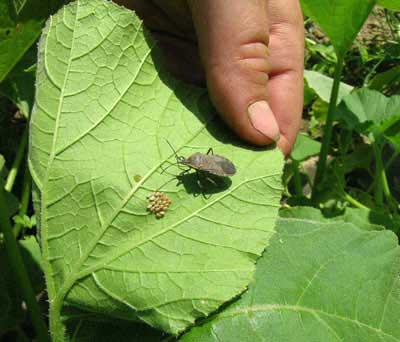 |
| Squash bug adult and eggs |
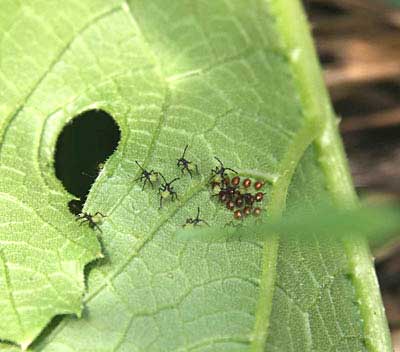 |
| Squash bug hatch |
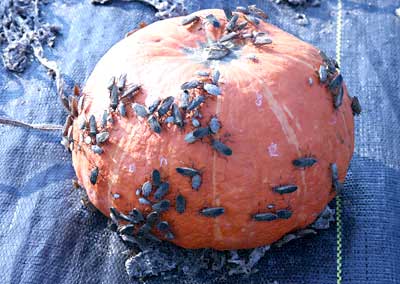 |
| Squash bug adults and older nymphs |
SQUASH BUG
By Eric Sideman
Squash bugs are serious pests of pumpkins and squash throughout North America. Plant damage, and bug survival, are low on watermelon, very low on cucumber and muskmelon, and highest on squash and pumpkin. Both adults and nymphs feed by inserting their beak and sucking juices from plant tissue. Toxic saliva injected during feeding causes foliage to wilt, then leaves turn black and die; the severity of this damage is directly related to density of squash bugs on each plant. Often I get calls from growers with squash bug problems who believe they have a disease. Later in the season, squash bugs may feed on the fruit, causing them to collapse or become unmarketable.
Adults are 0.5 to 0.75 of an inch long, flattened and grayish-brown. They hibernate in trash in and around the garden for the winter and emerge in the early summer to feed a bit and lay eggs. Eggs are laid in clusters usually on the underside of leaves and are orange when first laid, but turn bronze-colored before they hatch. The wingless nymphs are similar in appearance to adults, and are whitish when small, with a brown head, and grayish white when larger with black legs. There is one generation per year in the Northeast.
Black plastic, weed barrier fabric, straw mulch, and reduced tillage systems encourage higher populations, probably by providing good hiding places. Squash bug numbers are reduced by clean cultivation in the fall, and crop rotation. Infestation is delayed by row covers. If possible, rotate cucurbit crops between fields as far apart as possible. Keep headlands mowed and free of trash to reduce overwintering sites.
Squash bugs are unusually difficult to control with insecticides. Scout undersides of leaves for squash bug adults and eggs. Crush the eggs. You may not want to crush the bugs as they stink when you do.
If you miss some eggs and have to spray, try to time squash bug sprays to kill young nymphs just after hatch, because this stage is the easiest to control. Treat late in the day when the flowers are closed to reduce risk to bees. Neem products have proved effective.
For adult bug control, insecticides applied to the base of the plant are most effective, possibly because bugs tend to cluster. But, squash bugs are virtually impossible to control later in the season when nymphs are large and the canopy is dense.
(Source material from New England Vegetable Management Guide; Handbook of Vegetable Pests, A Capinera; ATTRA. And UMass Extension article by Andy Cavanagh & R Hazzard)
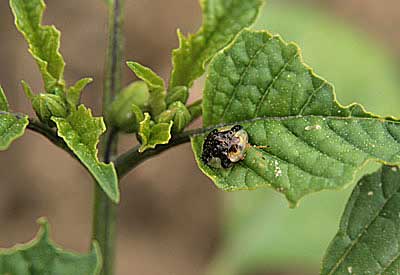 |
| Tortoise beetle |
TORTOISE BEETLE
These beetles are typically only a very minor pest, but I occasionally receive emails asking about them. They do not typically cause serious damage and do not warrant spraying. The numbers are usually small and the beetles can be picked off by hand.
They are oval to a square shape, clear to metallic looking with a dark square marking on the center of their back. Once you see one you will remember it (see photo). There are a few species of tortoise beetles. The one I getting the most questions about feeds on eggplants, tomatillos, peppers and potatoes. They overwinter as adults and come out in the mid spring. Their minor damage is from eating holes in leaves.
There is a species known as the golden tortoise beetle which can be a bit more of a pest, though they are beautiful to look at. They feed on sweet potatoes, and other species in the morning glory family, and can be a larger problem – though only if you are concerned about the aesthetic damage on foliage. When in small numbers, I recommend ignoring them or hand picking them off, as they are unlikely to cause enough damage to affect yields. If you have them, or other tortoise beetle species in large numbers, let me know.
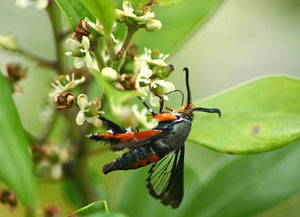 |
| Hawk moth – adult form of squash vine borer |
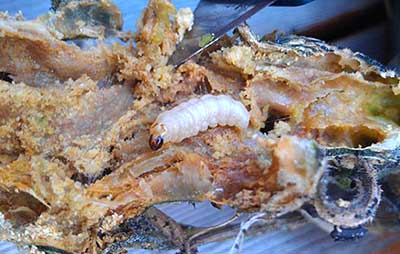 |
| Squash vine borer larva |
SQUASH VINE BORER
By Eric Sideman
Squash vine borer moths are day-flying moths with a 1.0 to 1.5 inch wingspan and bright orange markings. In flight, they look like wasps. There is one generation each year and adults emerge in late June/early July. The moths fly slowly in zig-zags around plants and lay eggs singly on stems; eggs are usually found on the main stem near the base, but are also found on leafstalks or on the undersides of leaves. Upon hatching, larvae bore into stems (where they are protected from insecticides). Thick-stemmed squashes are preferred. Unless you use traps or scout fields for evidence of eggs or larvae, the first sign of squash vine borer infestation is often wilting vines in July and August. By that time, it is too late to do anything.
Growers should scout their pumpkin and squash fields weekly for squash vine borer from late June through early August. Examine the base of vines for eggs. The squash vine borer can be killed with an insecticide and the recommendation would be spinosad (for example, Entrust or Monterey Garden Spray), but appropriate timing is crucial. Bt also works, but Bt breaks down more quickly. Bt aizawai (for example Agree WG) has been shown to work better than Bt kurstaki (for example Dipel). Either insecticide is only effective when applied for young larvae to eat before they bore into the stem. Once they are in the stem the insecticide will be useless. If you see the moths flying or find eggs,then two insecticide sprays, ideally applied to the base of the plants and timed five to seven days apart, will control newly hatching larvae before they are able to bore into the stem. Again, the timing is crucial and there is no point in spraying before you find evidence, or after the larvae bore into the stem.
If evidence of larval feeding (sawdust-like frass near entrance holes) is found, then split open the stem to confirm the presence of larvae, which, by the way, may suggest more eggs are being laid so scout. Borers can be removed from vines if detected before much damage is done. Slit the stem longitudinally, remove the borer, then cover the wounded stem with moist soil above the point of injury to promote additional root formation. Some growers swear by puncturing the stem many times over with a long thin pin or needle to reduce damage to the stem.
Some growers monitor for the moths using Scentry Heliothis pheromone traps from early June through early August. If more than 5 moths per week are captured, then they make 2 to 4 weekly applications of pesticides. Timing is very important, so this is not recommended for the casual gardener.
(Source material from New England Vegetable Management Guide; Handbook of Vegetable Pests, A Capinera; ATTRA, UMass Vegetable Newsletter and URI Extension Fact Sheet)
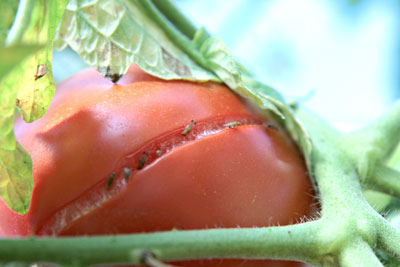 |
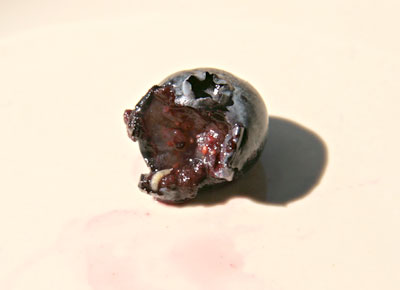 |
| Spotted wing drosophila on a cracked tomato | Drosophila larva in a blueberry |
SPOTTED WING DROSOPHILA (Drosophila suzukii)
By Eric Sideman
The spotted wing Drosophila, as most of you know by now, is a species of fruit fly that, unlike the typical fruit fly found around overripe fruit, can pierce the skin of just ripe fruit and lay an egg. Most of you also know by now that the egg hatches and the larvae consume the fruit from the inside out. Watch out for soft fruit.
The fly is easy to recognize. It looks like a regular fruit fly, but there are spots on the wings.
Management is all about harvesting and post-harvest handling. Pick the fruit often and do not allow ripe fruit to hang around. After picking, refrigerate or freeze quickly. Do not leave baskets of fruit at room temperature, unless you want to raise maggots.
Spinosad (Entrust or Monterey Garden Spray) is actually very effective, however not practical nor, in most situations, legal. The problem is that the fruit fly has a very quick and large ability to reproduce. The populations become very large by late summer. Spraying would have to happen every 3-5 days to be really effective, and there is a label limit of only 3 sprays per crop. So, management for organic growers is all about harvesting and post-harvest handling.
A great new guide to organic management of spotted wing Drosophila was released in 2018, and the pdf file can be found here.
